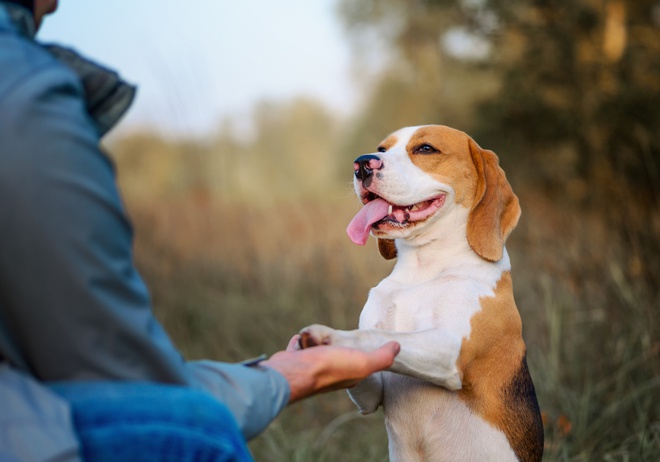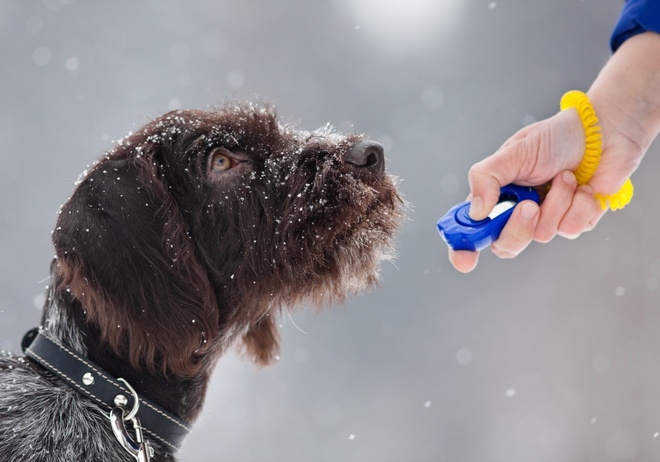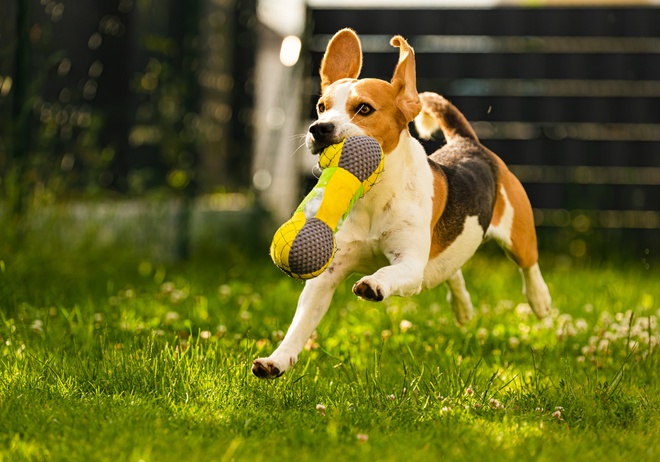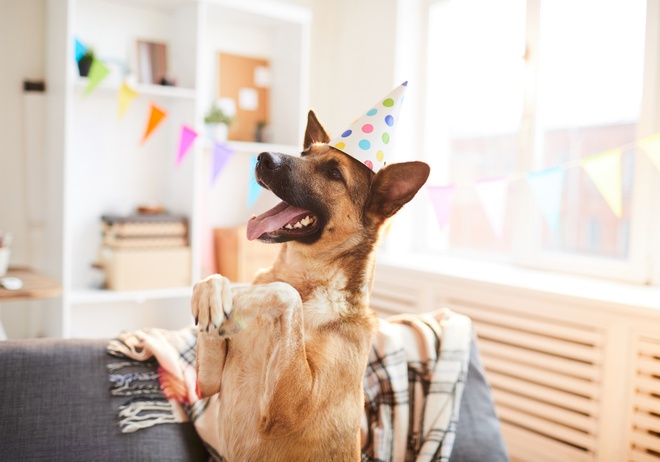8 tricks to teach your dog
Teaching a dog tricks might seem like a difficult task that only professionals can deal with, when in reality it can be very simple, pleasant and rewarding at the same time. In this article, you can find 8 tricks on different difficulty levels that you and your dog can work on together.

Reading time : 7 min
Majority of the dog owners limit their dog’s training to basic commands, such as sit, down, come and stay, when there are many other, more fun, yet still easy tricks they could move on to. House-training process doesn’t require help of a professional dog trainer or behaviourist, and some of the tricks can be taught even to a puppy.
Teaching your dog tricks can be a perfect opportunity for you to bond more with your pet, at the same time providing them with a stimulating and challenging activity. If you struggle to find time to play with your dog, training them can also serve as an occasion to show your affection. Moreover, it’s one of the best ways to improve the communication between the two of you. And imagine the awe on the faces of your family and friends when you present them the tricks you have mastered together!
TOPICS
Tips on teaching your dog tricks

Be patient
Like any form of pet training, teaching your dog tricks might be a long process. Make sure to start with the easiest tricks and increase the difficulty level gradually. Be patient and don’t get angry if your dog takes more time to master a new skill – the training is supposed to be fun for the both of you. Avoid yelling at your pet and speak calmly using an encouraging tone of voice, as any type of canine training should be based on positive reinforcement. Under no circumstances should you use punishment methods to make your dog more submissive – this might lead to behaviour problems and aggression.
Allow some rest and reward
Remember that to learn some of the tricks can be challenging and exhausting for your dog, both physically and mentally, so keep the training sessions short and upbeat in order not to discourage them. Repetition and patience are the key to success. Another great motivation for your dog will be delicious treats – they are an essential part of the training. Always keep healthy and high-quality treats at hand.
Get the right tools
When teaching your dog new tricks, you may resort to the use of a clicker. It’s an extremely useful tool used in training by conditioning. To find out more about clicker training, read our article in Chapter 7 of this guide.
Easy tricks to teach your dog

There are dozens of tutorials showing tricks of all levels, but remember that patience and positive enforcement are key. Dogs learn at different speeds depending on age. Start with simple first behaviors. Puppies in their formative months often learn quickly thanks to natural curiosity, while a senior dog may need shorter, calmer sessions.
If you are new to training, begin with easy tricks before moving to complex ones. Make eye contact, use hand signals if hearing impairments exist, and always reward progress.
How to teach your dog to shake hands
Shake hands is often one of the first behaviors dogs master, as they naturally paw. Puppies may learn fast, while a senior dog might need extra patience. Get your dog to sit calmly next to you. Hold a treat in your closed fist and present it. Use eye contact or hand signals to help dogs with vision or hearing impairments.
When your dog paws at your hand, click or praise, then reward. Repeat to strengthen learning speed with positive enforcement, adapting to each dog’s abilities. When the behavior is consistent, add the verbal cue “shake.” Later, show an empty hand but still reward. You can also teach a fun variation like a high-five.
How to teach your dog to kiss
This trick is simple but needs clear guidance, especially for a senior dog. Puppies in formative months may learn faster, but all benefit from patience and structure. Prepare treats and a clicker if used. Ask your dog to sit and settle on a mat. Hold a treat to your cheek, use hand signals, and make eye contact to guide the behavior.
When the nose touches your cheek, praise warmly or click, then reward to avoid licking. Adapt cues for hearing or vision impairments to match each dog’s learning speed. Repeat until the action is reliable. Gradually add a verbal command “kiss.” With natural curiosity and positive enforcement, your dog will soon respond on cue.
How to teach your dog to fetch
Fetch is a classic but not always natural. A senior dog may tire easily, while puppies in formative months often chase with curiosity. Patience is key for all. Choose a calm outdoor space to limit distractions. Pick your dog’s favorite toy to trigger natural curiosity. Use eye contact and hand signals to guide the training.
Throw the toy a short distance and call the dog back. Use a leash if needed and reward with praise and treats. Positive enforcement supports learning speed. Over time, increase distance and reduce treats. Even with vision or hearing impairments, dogs succeed if cues are clear and sessions remain motivating and fun.
How to teach your dog to spin
Spin looks tricky, but with patience and positive enforcement, most dogs learn it. Puppies may pick it up quickly, while a senior dog benefits from shorter lessons. Hold a treat low near the nose and lure them into a circle. Keep eye contact and use hand signals if needed. Click or praise, then reward when the spin is complete.
Gradually reduce the lure, adding the command “spin.” Adapt methods to your dog’s learning speed, especially with hearing or vision impairments. Teach one direction at a time to avoid confusion. With practice, natural curiosity, and repetition, your dog will master spinning while enjoying the process.
10 questions to test your pet training knowledge
Do you know everything there is to know about training dogs and cats? Answer our 10 questions to find out!
More advanced tricks to teach your dog

Once you’ve mastered the basic tricks, you and your dog should be ready to up your game and move to higher level. We encourage you to try teaching your dog one of the following, more advanced tricks.
How to teach your dog to bow
Teaching the dog to bow is based on the same luring gesture as down, so make sure that your dog has this trick under control before starting with the new one. Firstly, make your dog stand still without shuffling their feet around and keep feeding them treats as long as they stay in this position.
Then, move the treat into the dog’s direction so that they make a small shoulder dig, rewarding every successful movement with the treat. Once your dog has this move under control, without shuffling their feet, you can start making the dip deeper, eventually going all the way down to the floor. It’s important to feed your dog treats already in the standing position, so that they learn the whole movement. Similarly to the previous tricks, you may want to add a verbal command, like “bow,” as well as a release cue.
How to teach your dog to play dead
To teach your dog to play dead might take a bit more persistence and time, but it is definitely worth it. Start by putting your dog in a down position. After you get them to lie down, lure them with a treat to roll on their side, at the same time saying the verbal cue “play dead.” As soon as the dog is in the laying position, praise them and reward them with the treat (and click if you’re using the clicker). Repeat the trick, fading the lure with time and introducing hand signals and a verbal cue. After some time, you can also train your dog to lie in the position for longer.
How to teach your dog to sit pretty
Sit pretty is not only an effectively looking trick, but it is also a great exercise for the dog, helping them build core muscles and keep balance. However, before starting the training, check with the vet to make sure that your dog is healthy, as the position can strain pre-existing conditions. Always put your dog’s safety and well-being first.
Lift the treat over the dog’s nose and lure them into position. Click and praise the dog as soon as their feet move off the ground, then give them the treat. Make sure that your dog is sitting straight on their back feet. If they find it difficult to keep balance, you can support their weight with your arm or a chair. Once the dog stays in the position for 5 seconds, you can start removing the lure and adding a visual and verbal cue, for example “sit pretty.”
How to teach your dog to hug
Teaching the dog to hug is a piece of cake once your dog knows the sit pretty trick. Start by making your dog sit pretty, then lean forwards saying “hug” and wrapping your arms around your dog at the same time. Use the clicker and reward your dog with the treat when they execute the trick. Gradually turn to just using the hug command, at the same time teaching your dog the visual cue, which might be opening your arms.
If you know that your dog doesn’t feel comfortable when they’re being touched, gets fearful and anxious when you try to hug them, it’s better to focus on different tricks or make use of dog training services.
Conclusion
Introducing various activities into your dog’s life is a crucial part of caring for their well-being. Tricks should match your dog’s age appropriateness and breed suitability. While teaching foundation behaviors or more complex tricks, always consider health conditions or mobility issues, especially for senior dogs.
Activities like platform training, rear end awareness exercise, or simple obedience position changes are safe ways to stimulate body and mind. Similarly to other types of training, you need to rely on patient practice. Respect your dog’s practice limitations while enjoying quality time together.
Continue reading our guide
This article is a part of a complete guide on the subject. Do not miss the next chapters.
Do you know everything there is to know about training pets?
Answer our 10 questions to test your pet training knowledge.
